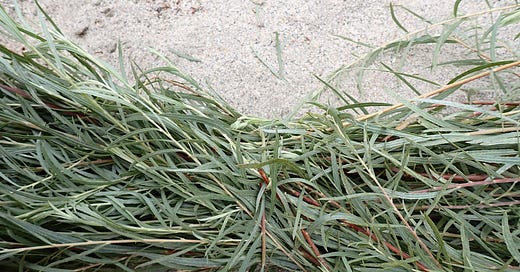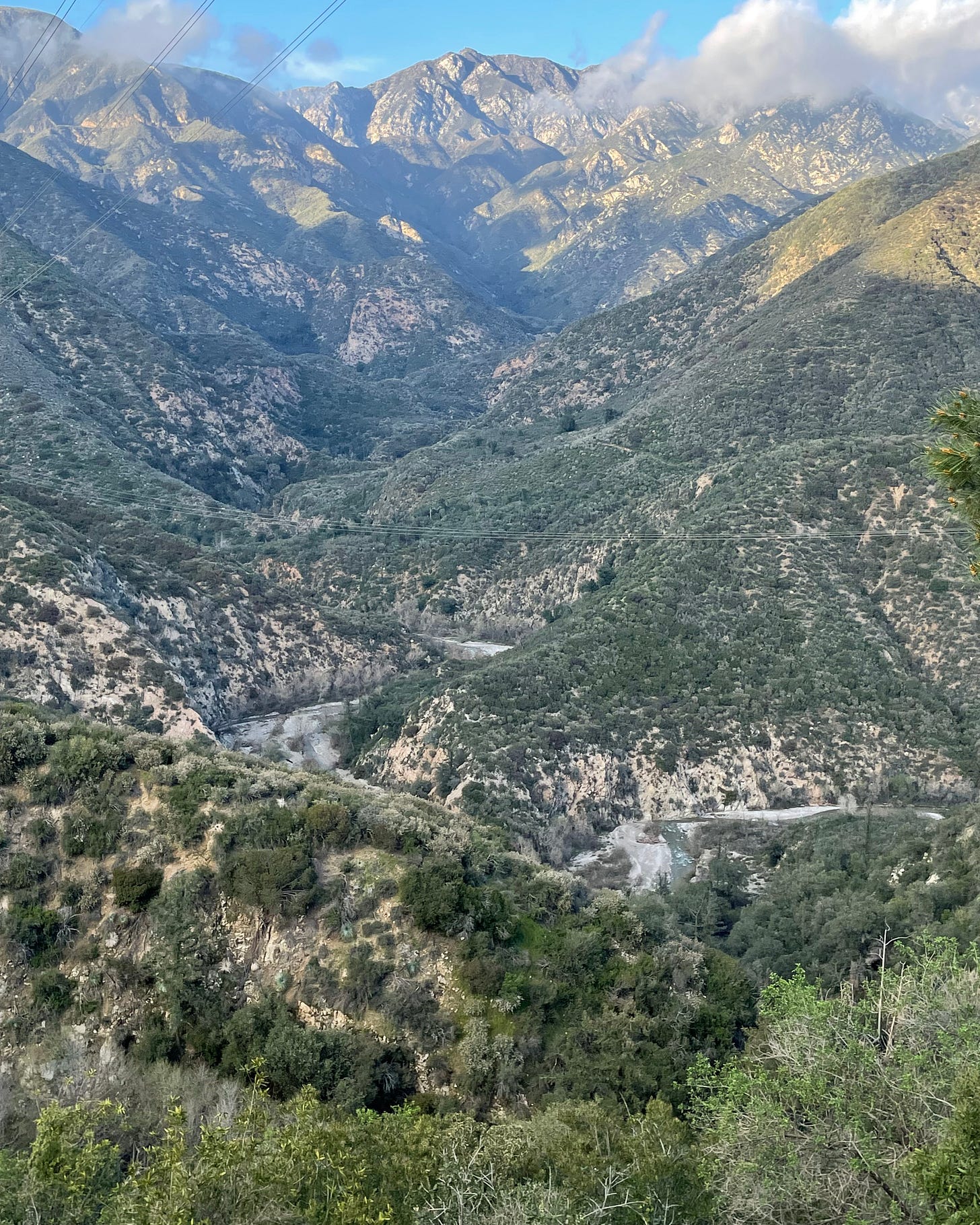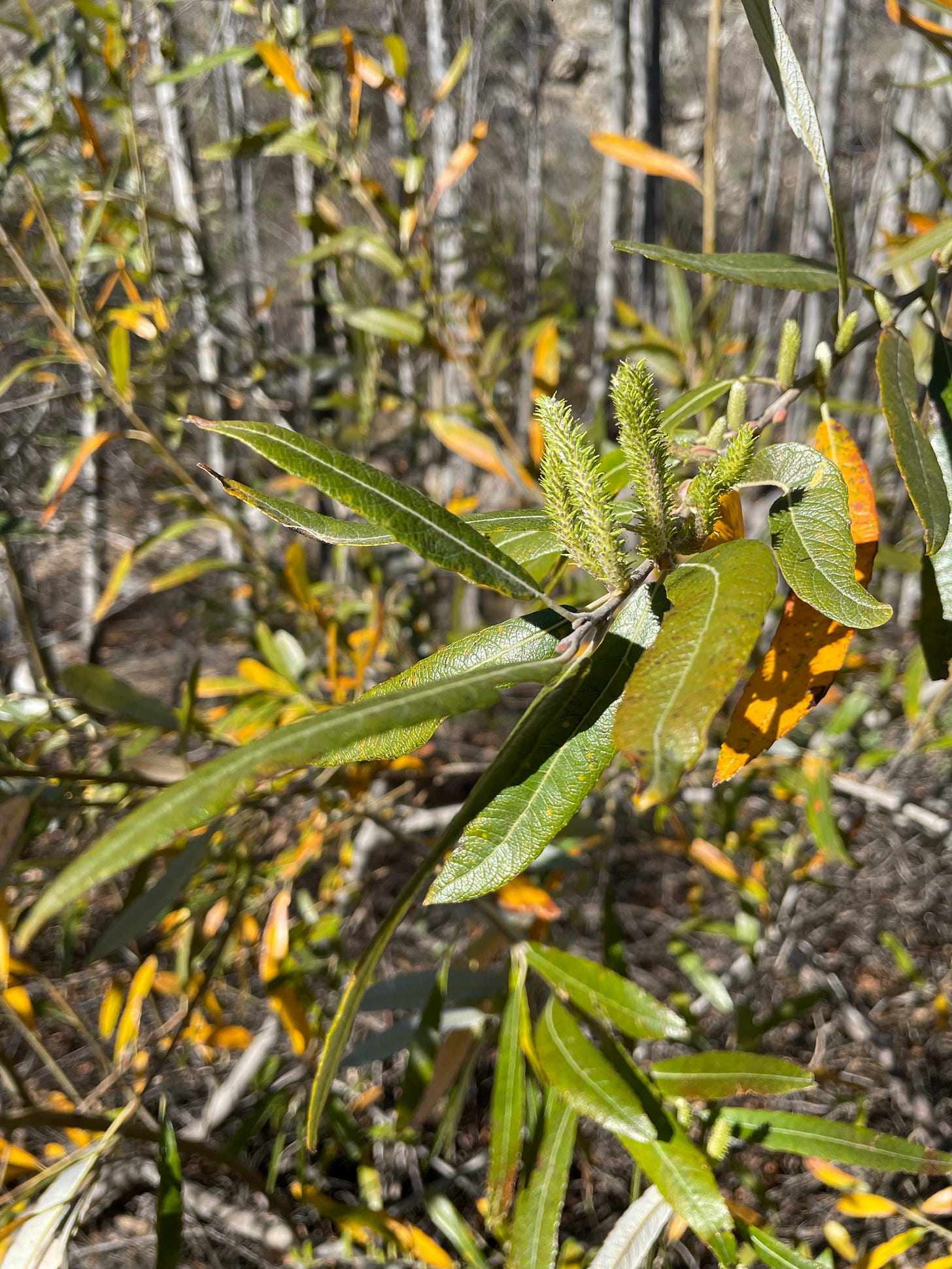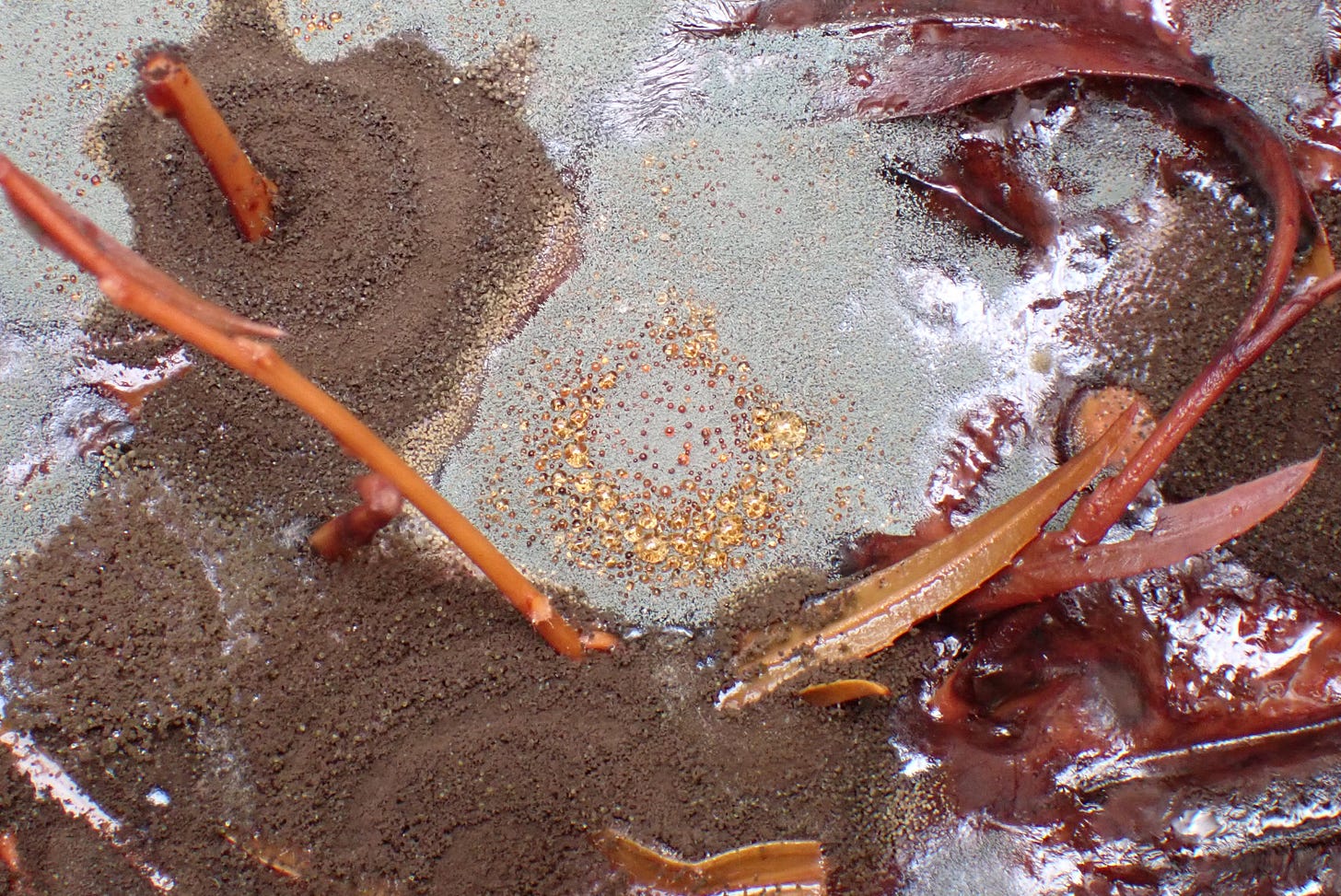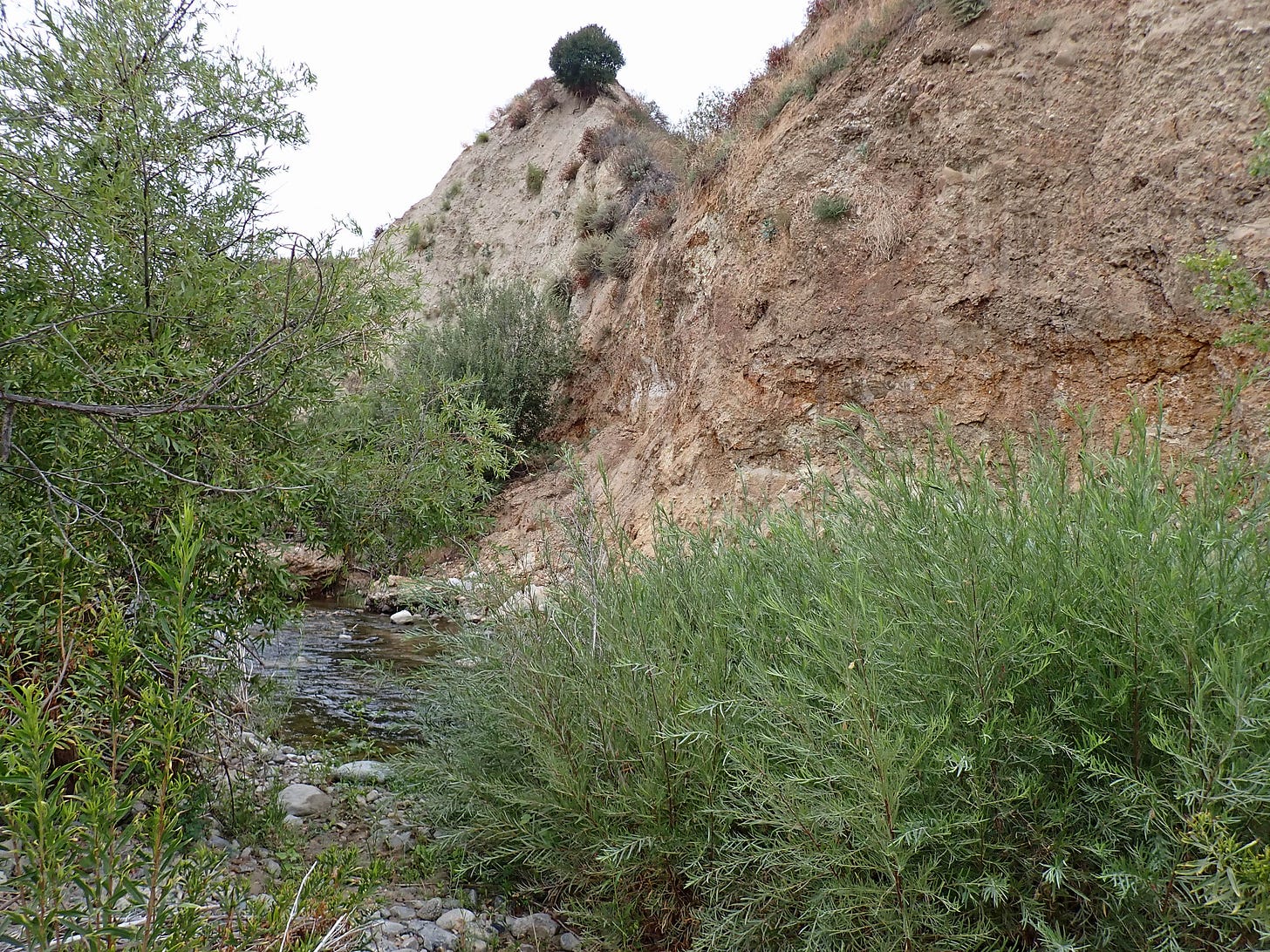Colors of the Arroyo: Willow
Part one of a series exploring the ecology and natural colors of my home watershed
Author’s note: Around this time last year, when some things I’d been thinking about began tugging at my sleeve to write about them, I’d go to the arroyo to think and walk and think and walk. I packed the streamside paths with my footfalls, compacting the dirt compacted by other countless feet walking these trails over thousands of years, simultaneously trodding and solidifying ways and spur trails in my mind as I went.
With my walking I was asking for some hint from the silent, gorgeous river gods—the swaying willows and scarlet monkeyflowers; the ancient, millions-of-years-old boulders collected like trinkets by the water’s ceaseless flow; the weaving spiders and single berry-eating bear I encountered—of how to write a story of this place, how best to create alongside it and honor it with what I make, and how (I hope) that all might translate as inspiration for others to do a similar outward and inward exploring, leading to deeper knowing, caring, and tending.
An answer didn’t arrive one fateful day, but little, ephemeral clues emerged as I watched the river go through its roiling rainy season changes. In mid-winter I stood on its banks witnessing its sheer flooding force, the once-silent ancient boulders now knocking together like billiard balls in the current, and had a small sense of surrender, of being swept away. The trails closed from storm damage. I contrived entrances and exits by other means, further upriver, and saw rainbow trout and alder trunks drawn deep with bear claws. In spring, the blue dicks bloomed for nearly no human audience, and in summer when we were all invited back, the pools ran deep from a river whose shape and path had changed, and we swam in them.
One fall day I rushed back home in my still-wet socks to start writing about the changes I noticed, in the river and in me. A theme was emerging outside of my conscious knowing, and after that day I began treating my trips to the stream as a journalist might, observing an unfolding, unending story that I had simply to get out of the way of to report. The water, the kinship all life shares with it, the ways it shapes land and plants and others and us, is the story. The river flows, the place changes, and I try to tell this story with my limited palette of language (and natural color).
Maybe you noticed a shared theme with the writings I’ve posted here before I did. It wasn’t an intentional direction, and like so many creative expressions, appeared un-summoned and nearly unbeknownst to me, seemingly of its own volition. Now I’m following it faithfully, like the changing path of my home river, and documenting where it takes me. Shared below is the first purposefully themed piece I’ve written, part of a series that is developing about the plants of my local watershed, how water shapes their existence, and my practice of learning and creating with them.
Colors of the Arroyo: Willow
The tangles of willows in the wide washes of the arroyo have seen many cycles of drought and flood, drought and flood. Known to the Chumash as the Tree of Tolerance—and associated symbolically with women—for the willows’ ability to bend and rarely break, their flexible limbs fare powerful floods and have been used to build the curved roofs of homes, and as basket weaving strands; their fibrous bark as cloth and cordage, and as powerful, pain-relieving medicine. Back here they form dense thickets in the flats of the wild arroyo, inhabiting bare creek bed and stream bank, sandbars and tiny islands.
There are five species of willow populating this stretch of stream. The most abundant is arroyo willow (Salix lasiolepis) with its lance-shaped leaves, rich green on top and pale, glaucous gray below. It’s easy to spot red willow (S. laevigata) with its young red branches and ruddy bark, and pacific willow (S. lasiandra), sometimes called shining willow, with its distinctly glossy leaves reliably catching glints of sun. There is Goodding’s willow (S. gooddingii), growing to towering tree-heights, sloughing off shredded bark as it grows; and finally, the pioneering willow species I’ve come to know best, narrowleaf willow (S. exigua)—sometimes termed the sandbar willow for its preferred substrate—with wisp-thin leaves and slender limbs which quiver in the wind. Together they all shed their leaves in a chorus each winter, returning to life after the cold months with fuzzy, caterpillar-like flowering catkins.
Willows are browse for deer, but like so many other plants, they harbor tannins as a defense against wild indulgence. Tannins are a type of naturally occurring chemical compound, and they are bitter and astringent, potentially sick-inducing, and dehydrating to consume. But medicine is rarely sweet-tasting; I’ve heard anecdotally of wounded and sick animals eating willow leaves to treat their pain—all willows contain salicin, the chemical namesake for their genus (Salix) and a precursor from which humans derived modern aspirin—and young bucks rubbing the nubs of their tender incoming antlers on the trunks, seeking relief.
Many of the willows in this area are clones of one another. My guess is that some of this population have built up particularly high tannin defenses, as they produce a rich caramel-colored dye, shifting readily to chocolate with the introduction of an iron post-treatment; in dyer’s terms, this “saddening” of dye color when iron is introduced is a definitive indicator of tannin content. Naturally selecting over generations for increased tannins means higher willow survival rates from predation. Combine this with their uncanny ability to populate by re-rooting, especially in response to flood disturbance, and willow becomes an emblem for specialized resilience in this place where water inundates and reshapes and recedes, ad infinitum.
Running through willows’ circulatory system is indole-3-butyric acid, or IBA, a powerful plant hormone which stimulates rooting. Paired with salicin, which protects fresh cuttings from infection by bacteria or invasion by fungi, and even deeper layers of their repopulating powers are revealed. When willows are forced beyond their bending to break, losing limbs in strong currents, these shedded parts are swept downstream to find purchase in other nearby banks, populating a place with genetic copies, colony by colony.
Narrowleaf willow in particular, a post-flood pioneer plant in these parts, has extremely high seedling mortality—few willows are produced sexually, by seed—but boasts a 95-99% success rate of rooting by cutting. They can resprout from a parent plant, even if buried in sediment, and regenerate readily from stems and roots broken apart by high stream flow. They quickly populate areas with fresh alluvial deposits, finding new life in exposed, wet soils.
Once on a road pullout overlooking a deep gorge cut by the San Gabriel River, I encountered two wildlife biologists monitoring stream flow. The river was flowing at ten times its normal volume, they said, this day after a major storm. From above, the spring-green tops of tall willows could be seen swaying like strange river-kelp in the deep and powerful current. One biologist said he’d seen willows survive under flooded waters for months. While most plants can’t survive underwater for any length of time—their cells unable to obtain the oxygen needed for respiration—willows, when immersed for more than a few days, begin to produce adventitious roots from their submerged trunk and branches, while openings called lenticels higher up the trunk move oxygen to their submerged parts. In greenhouse studies, narrowleaf willows have survived for an amazing five months underwater.
These fibrous, adventitious roots are also partly responsible for the dense tangles of willows on the stream stretch I wander. Their roots quite literally knit the land together, building foundations and protecting shorelines, stabilizing and revegetating scoured stream channels as they grow rapidly into replicating networks. The matrices of roots also act as filters during floods: catching sediment and nutrients, returning them to soil, filtering water and improving its quality; aiding riparian areas, which in their essence act as sponges, in absorbing floodwaters and refilling the land’s deep drink of groundwater.
Narrowleaf willow (S. exigua) is my chosen willow for dye, with its warm caramel dye color and matching sweet-smelling brew: like caramelizing sugar, as the dye infuses and oxidizes from sunny yellow to something richer, deeper, sweeter. So many plant dyes begin the way willow does in the pot: a subtle, pale yellow liquor, the color (I suspect) of chlorophyll cooking off, smelling gently vegetal and looking like a weak tea before the sensorial show really begins.
A small bundle of willow stems, leaves on, gathered just before the plant goes dormant and sheds leaves on its own, chopped into small pieces, simmers for an hour before revealing its deeper color and sweeter scent. I toss a piece of mordanted cotton in to collect color for a test, ten to fifteen minutes, and it goes from mustard to orangey to a deep tan with red tones in minutes. This is the time to celebrate: anything outside of common yellow from a plant dye is a rare gift.
There are many ecological and ethical complexities to consider when gathering plants from the wild. I collected my first willow for dye from the Tujunga Wash after a storm, the streamway strewn with natural and non-natural debris and cut into countless wandering channels of fast-flowing water. I found the downed branches in a tangle of plastic fibers, caught by a small wall of fellow riparian kin, mulefat. I didn’t know about willow’s rooting superpowers, so I did what I do with so many plant windfalls: took the plant material home for a dye experiment. Now I know that my first willow might have fared fine as storm detritus; it might have rerooted, and become a clone of many clones deepening the thicket of itself.
Untold generations of Pomo basketmakers have tended stands of narrowleaf willow, aiming to induce straight shoots and long underground runners (rhizomes) used for weaving. Pruning Salix exigua aboveground induces the plant’s subterranean rhizomatic growth, fostering a vast network of lateral shoots used in particular for coiling into large baskets. “The cultivation by the weavers helped the willow to spread, kept it from getting top heavy and falling down, removed diseased branches, and increased its effectiveness in controlling erosion along the stream banks.” (M. Kat Anderson 140)
Downstream of the San Gabriel River is the manmade Santa Fe Dam, a flood control built in the 1940s. Below the dam is a basin with some intact, increasingly rare alluvial scrub habitat atop a river-deposited alluvial fan. With numerous highly trafficked trails along the river and around the basin, the area is heavily impacted by modern human use, and a panoply of non-native and invasive plant species can be found growing there. On a botanizing outing a few months ago with Keir Morse and Margaret Gallagher, we discovered a nascent population of stinkwort (Dittrichia graveolens), a sticky and aromatic sunflower-family plant native to the Mediterranean and southwestern Asia, just burgeoning into yellow fall flower. We uprooted the plants, invasive but yet to widely establish in the area, while Keir made meticulous note of their location.
I took the medicinally-scented, sticky plants home to brew a test dye, finding they made a lovely, saturated sun-yellow, shifting to dramatic deep olive with the introduction of an iron (ferrous sulfate) post-treatment. The dye brew was viscous with an oily sheen on top, likely from the volatile compounds responsible for the plant’s strong smell and tack. Days or weeks later, the plants would have begun their seeding phase, producing countless small wind-carried seeds (think: dandelion)—grounds for their success in establishing here on their non-native soil—and harvesting them at that point would have arguably caused more harm than good, spreading seeds widely in the uprooting and transporting of these unwelcome guest plants.
It can be comforting to divide our choices and actions into simple, binary categories: as in, harvesting native plants is ecologically bad, and removing invasives is universally good. While this may hold true as a generality, I’m inclined to explore the messy middle, where examining upheld mores may yield deeper noticing, richer questions, and expansive possible answers. Harvesting—tending—willow as a beneficial disturbance to the plant, with the aim of inducing growth and fostering health and abundance, has the potential to positively impact both individual plants and the wider wild (and human) community. Uprooting and utilizing stinkwort for dye is an inarguably beneficial ecological practice, with the caveat that the plant is not presently seeding. To enter indiscriminately into a tidy and binary thought process here, we may unintentionally spread seeds we wish to limit, or inhibit the sort of growth which we aim to foster.
Willows choose life by the water which floods and recedes, despite or because of the ways it changes them, rooting new versions of themselves with every transformative disturbance. The whole changes and grows as parts of it are released, shed in the flood, some fragments re-rooting in newly churned soils to develop their own novel provinces downstream. As the willows do, can we shed old versions of our selves and our once-held beliefs, allowing the generous earth to reabsorb them, while making space for new growth? Let us honor the resilient new which emerges from the jettisoned old. The cast-off pieces which withstand the flood become part of the ever-changing ecology of our whole, collective beings, new cuttings rooting in the willow forest of our ever-evolving selves and communities.
Works Consulted:
Adams, James et al. Healing with Medicinal Plants of the West. Abedus Press, 2005.
Anderson, M. Kat. Tending the Wild: Native American Knowledge and the Management of California’s Natural Resources. University of California Press, 2005.
Anderson, Michelle. “Salix exigua. In: Fire Effects Information System.” US Department of Agriculture, Forest Service, Rocky Mountain Research Station, Fire Sciences Laboratory, 2006, https://www.fs.usda.gov/database/feis/plants/shrub/salexi/all.html.
Timbrook, Jan. Chumash Ethnobotany: Plant Knowledge Among the Chumash People of Southern California. Heyday, 2007.


